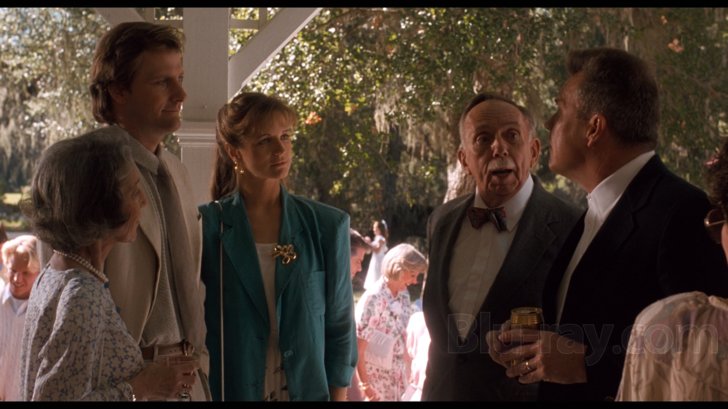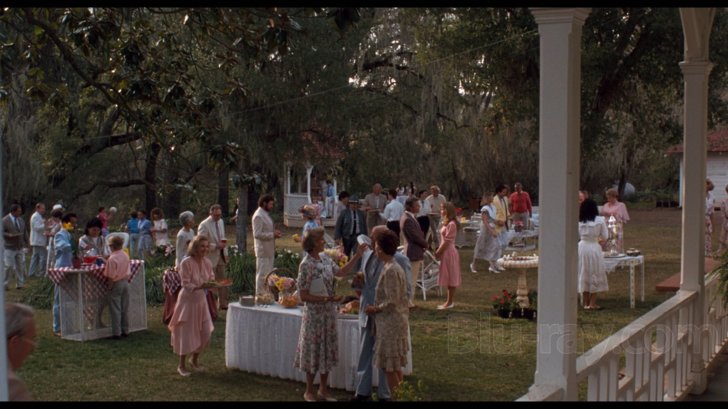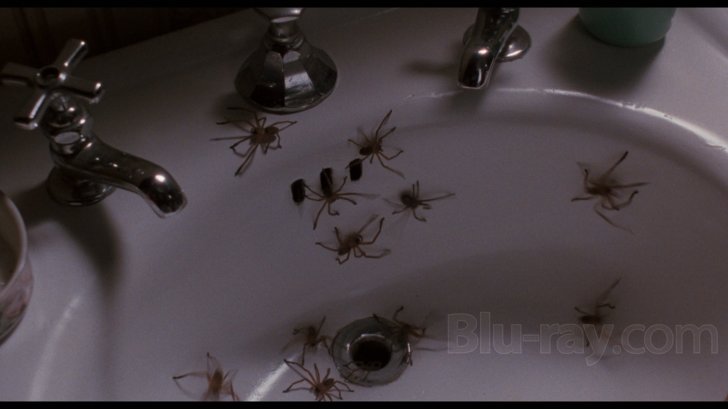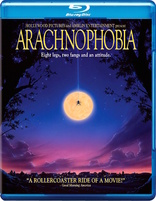Arachnophobia Blu-ray Movie
HomeArachnophobia Blu-ray Movie 
RemasteredDisney / Hollywood | 1990 | 110 min | Rated PG-13 | Sep 25, 2012
Movie rating
7 | / 10 |
Blu-ray rating
| Users | 3.6 | |
| Reviewer | 4.0 | |
| Overall | 3.6 |
Overview
Arachnophobia (1990)
A large spider from the jungles of South America is accidently transported in a crate with a dead body to America where it mates with a local spider. Soon after, the residents of a small California town die as the result of spider bites from the deadly spider offspring. It's up to a couple of doctors with the help of an insect exterminator to annihilate these eight legged freaks before they take over the entire town.
Starring: Jeff Daniels, Harley Jane Kozak, John Goodman, Julian Sands, Stuart PankinDirector: Frank Marshall
| Horror | Uncertain |
| Teen | Uncertain |
| Thriller | Uncertain |
| Comedy | Uncertain |
Specifications
Video
Video codec: MPEG-4 AVC
Video resolution: 1080p
Aspect ratio: 1.85:1
Original aspect ratio: 1.85:1
Audio
English: DTS-HD Master Audio 5.1 (48kHz, 24-bit)
Spanish: Dolby Digital 2.0
French (Canada): Dolby Digital 2.0
All DD 2.0=320 kbps
Subtitles
English SDH, French, Portuguese, Spanish
Discs
50GB Blu-ray Disc
Single disc (1 BD)
Playback
Region A, B (C untested)
Review
Rating summary
| Movie | 4.0 | |
| Video | 4.0 | |
| Audio | 3.0 | |
| Extras | 1.0 | |
| Overall | 4.0 |
Arachnophobia Blu-ray Movie Review
Not So Itsy Bitsy
Reviewed by Michael Reuben September 23, 2012(Note: The following is a revised version of the review that originally appeared on August 28, 2012. It is based on the remastered disc of Arachnophobia with a street date of September 25, 2012.) In the Rocky Horror Picture Show's opening anthem to classic sci-fi movies, we're reminded that Leo G. Carroll was "over a barrel" when Tarantula took to the hills. The hero of Arachnophobia, Dr. Ross Jennings, finds himself in much the same position, physically and psychologically, when a new species of spider appears in small town America. The old monster movies typically blamed atomic radiation, but in Arachnophobia the culprit is scientific exploration, which unleashes a heretofore unknown species of South American arachnid on an unsuspecting world. The spiders of Arachnophobia don't behave like any eight-legged variant we've seen before. They're aggressive, organized and purposeful. In their own world, as the expert played by Julian Sands explains, they inhabit the top of the food chain. Indeed, their behavior often mimics the vampires of legend; one character even makes the comparison out loud. The progenitor of the epidemic arrives on our shores in a coffin, accompanying a body it has entirely drained of blood. The creature has an affinity for dark and damp locales, is able to hypnotize Dr. Jennings into immobility with a glance, and bites its victims with two incisor-like fangs. When the exterminator, Delbert McClintock—who is Arachnophobia's resident Van Helsing—sprays the monster's progeny with his specially prepared "private stock", they steam and melt like vampires sprayed with holy water. The vampire references, visual and otherwise, are part of Arachnophobia's subversive sense of humor, which transforms what would otherwise be a gross-out bug story into a Ghostbusters-style comedy where even the deaths are funny. (I dare you not to laugh over at least one of them.) Long before Joss Whedon created Buffy, vampires had become comic fodder, as George Hamilton proved with Love at First Bite (1979). The script for Arachnophobia, co-written by Don Jakoby, who also wrote Lifeforce and John Carpenter's Vampires, fully exploited those possibilities to make spiders just as funny, and director Frank Marshall capitalized on the opportunity with inspired casting choices like Jeff Daniels and John Goodman, who are equally adept at comedy and drama.

In Venezuela, Dr. James Atherton (Sands) and his local research assistant (Juan Fernández), undertake an expedition to the bottom of a huge sinkhole in the mountains where prehistoric species of insects have flourished unchanged for millions of years. They are accompanied by a photographer, Jerry Manley (Mark L. Taylor), whom Atherton has hired to document the expedition. Manley suffers a fatal spider bite in his tent and dies instantly, but because he arrived suffering from a viral infection, his death is attributed to natural causes. His body is shipped home to Canaima, California. An eight-legged passenger hitches a ride in the primitive wooden coffin. When Manley's body arrives home, the local undertaker, Irv Kendall (Roy Brocksmith from the original Total Recall), takes one look at the remains and advises a closed casket. On the same day, the family of Dr. Ross Jennings (Daniels) arrives to begin their new life in the country. Refugees from the pressure cooker life of San Francisco, the doctor, his wife, Molly (Harley Jane Kozak), and their two children have bought an old farm house ("the old Daniels place", an inside joke), seeking a quieter life. Dr. Jennings has his doubts about the move, but the more immediate problem is the elderly local physician, Dr. Sam Metcalf (Henry Jones), who'd promised to retire and turn over the town's practice to Jennings. Metcalf has a sudden change of heart, leaving Dr. Jennings without the income he anticipated to support his family. A retired school teacher, Margaret Hollins (Mary Carver), volunteers to be Jennings' first patient, but not long after her physical, she dies of what Metcalf says was a heart attack. Other deaths follow in quick succession, all somehow related to the new doctor, who quickly acquires the monicker "Dr. Death". The officious local sheriff (Stuart Pankin) won't allow any autopsies to determine the true cause, which we know to be spider bites. Everything changes when old Dr. Metcalf himself becomes the latest victim, and his wife (Frances Bay) says he was bitten by a spider. Jennings identifies a spider bite on the body and calls in the world's leading authority on spiders, who just happens to be Dr. Atherton. He arrives preceded by his assistant, Collins (Brian McNamara), and eventually Jennings puts together Atherton's name with that of Jerry Manley, the former Canaima resident who died on Atherton's expedition. That's when they all realize they're dealing with a new species of spider, the product of cross-breeding Atherton's recently discovered Venezuelan variety with a common American variety. While the various doctors and scientists piece together the evidence and search for specimens, the local exterminator, Delbert McClintock (Goodman), has been responding to reports of spider infestation with growing determination. He and Dr. Jennings will eventually join forces to fight the menace, and it's good thing for Jennings, because Delbert knows no fear, while Jennings is paralyzed by the mere thought of spiders due to a childhood trauma. As events play out, though, it will be Jennings who has to face his fear and defeat the invaders. Director Marshall, making his feature debut, is one of the principals of Steven Spielberg's Amblin Entertainment. Marshall produced Raiders of the Lost Ark and Who Framed Roger Rabbit, among others, and he had obviously absorbed numerous lessons in the craftsmanship of structuring suspenseful sequences while maintaining a humorous tone. Marshall wisely secured the services of Spielberg's resident editor, Michael Kahn, and the long, elaborate set piece that serves as the film's climax has the style and rhythm of a first-rate sequence from an Indiana Jones film. Just substitute spiders for snakes.
Arachnophobia Blu-ray Movie, Video Quality 

After several false starts, Arachnophobia completes its trip to home video in a presentation that finally presents the film to good advantage. The 1999 DVD release of Arachnophobia wasn't enhanced for 16:9 and suffered from a weak video transfer. The initial pressing of the Blu-ray, which Disney withdrew prior to the original Sept. 4, 2012 street date, suffered from incorrect black levels that were especially noticeable in the Venezuelan sequences. The remastered 1080p, AVC-encoded Blu-ray that streets on Sept. 25, 2012 corrects the black levels and features a vastly superior image. The details of the countryside, the various styles of clothing, the Jennings' ramshackle barn, the elaborate spider webs, the spiders themselves (the small ones a harmless New Zealand breed, the large one a giant tarantula, plus an animatronic model) are all readily visible. The resolution is so good that in some shots you can even make out the thin wires attached to the spiders by their wranglers to control them. The image is somewhat soft, which is appropriate not only to the subject matter, but also because the film pre-dates the hard-edged digital look that has become standard twenty-two years later. (The cinematographer was Mikael Solomon, who shot The Abyss.) With black levels appropriately set, the visible detail is even better on the remastered version. Colors generally run to the pastel and delicate, but they are now better saturated without the unnecessary overlay of gray on the original Blu-ray. The Venezuelan sequences are the most obvious beneficiary of this improvement, because there is no longer a distracting milky background or hazy overlay, and the greens of the jungle are truly verdant. In the shot where the expedition sees two colorful macaws fly by against a neutral background, the intense hues of the plumage stand out now, just as they should. The one aspect of the South American scenes that may give viewers pause—and it may even explain why the brightness levels were initially cranked up too high—is that the opening sequence, before the expedition descends into the "sinkhole", now looks unusually dark. Since the rest of the film appears correct, this has to be attributed to the original element; it may well be a result of the optical superimposition of the credit sequence, which ends just before the expedition reaches the bottom of the sinkhole. There is only one slightly negative side effect of the correct brightness level, which is that video noise is occasionally more visible than it was when the grayish blacks washed it out. It's a small price to pay for the many benefits of an overall more accurate image, and, on the plus side, it's confirmation that the image hasn't been compromised by filtering or other noise reduction techniques.
Arachnophobia Blu-ray Movie, Audio Quality 

The standard release format for Arachnophobia was Dolby Surround, and IMDb indicates that there was also a 70mm blow-up with six-track sound. Unlike some other DTS-HD MA 5.1 tracks I have reviewed recently for which a six-track mix was prepared at the time of release, the track for Arachnophobia did not exhibit noticeably more bass extension or obvious separation than a Dolby Surround mix repurposed for 5.1. The dialogue and effects are clearly rendered, and there's a general sense of ambiance, but few showy rear channel effects grab your attention. (This may be because the film's villains are stealth aggressors who attack in silence.) The most obvious exception is a brief early sequence in Venezuela when the expedition uses smoke to cause insects to fall from a large tree, and the impacts can be heard around the room. The dialogue is always clear, even when John Goodman deliberately slurs and swallows his words for comic effect. The tongue-in-cheek horror score by Trevor Jones has been well-recorded and pitched at just the right level of urgency.
Arachnophobia Blu-ray Movie, Special Features and Extras 

- Production Featurette (SD; 1.33:1; 2:48): The sober pronouncements of the UCLA psychologist are as funny as anything in the film. Did you know that fear is an emotional reaction?
- Frank Marshall Featurette (SD; 1.33:1; 3:10): Using many of the same clips as the "Production Featurette", this piece provides substantive information about the spiders and Marshall's approach to the film.
- Venezuela Sequence (SD; 1.33:1; 1:29): A short look at the Venezuela location.
- Theatrical Trailer (SD; 1.33:1; 2:05): A "thrill-omedy"?
- Additional Trailers: At startup the disc plays trailers for Frankenweenie and Who Framed Roger Rabbit on Blu-ray, plus an anti-smoking PSA. The first two are available from the main menu as "Sneak Peeks", along with trailers for The Avengers, ABC TV on Blu-ray, Castle: Season 4 and ABC TV on DVD.
Arachnophobia Blu-ray Movie, Overall Score and Recommendation 

Disney surprised everyone by recalling Arachnophobia to address its issues, and address them they have. I have no hesitation recommending the remastered Blu-ray, because the film is a lot of fun, and its treatment on Blu-ray is a fine presentation for a film of this vintage. As noted in my original review, the disc has more extras than various "anniversary" releases of live-action films issued by Disney with much fanfare this year. Fans should be pleased. Now if we can just get Disney to do something about The Color of Money.
Similar titles
Similar titles you might also like

Puppet Master: The Littlest Reich
2018

Devil Dog: The Hound of Hell
Special Purebred Edition
1978

Prey
2007

Fright Night
1985

Hatchet
Unrated Director's Cut
2006

Piranha 3D
2010

Prom Night
Special Edition
1980

Prom Night
Unrated Version
2008

Sorority Row
2009

Slotherhouse
2023

Nightmare Man
2006

Red Christmas
2016

Lake Placid
Collector's Edition
1999

Corporate Animals
2019

Hatchet III
2013

Halloween 4K
Collector's Edition
1978

Assassination Nation
2018

The Faculty 4K
Collector's Edition
1998

Halloween H20: Twenty Years Later 4K
Limited Edition
1998

Hellbenders 3D
2012
